

Compact Muon Solenoid
LHC, CERN
| CMS-PAS-EXO-16-030 | ||
| Search for light vector resonances decaying to quarks at √s= 13 TeV | ||
| CMS Collaboration | ||
| July 2016 | ||
| Abstract: We perform a search for light, narrow vector resonances decaying to quarks in the mass range from 100-300 GeV produced in association with a high transverse momentum jet using 2.7 fb−1 of 2015 √s= 13 TeV proton-proton collision data collected by CMS. Novel jet substructure methods and background estimation techniques are employed to search for a resonance in the jet mass distribution originating from a new particle in whose decay the quarks are merged into a single jet. We demonstrate the CMS sensitivity to vector resonances in the mass-coupling phase space not yet explored at the LHC or by any past experiments. | ||
|
Links:
CDS record (PDF) ;
CADI line (restricted) ;
These preliminary results are superseded in this paper, PRL 119 (2017) 111802. The superseded preliminary plots can be found here. |
||
| Figures & Tables | Summary | Additional Figures | References | CMS Publications |
|---|
| Figures | |
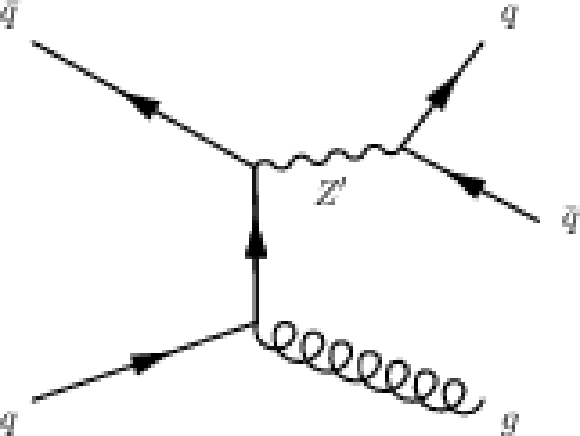
png pdf |
Figure 1:
An example Feynman diagram of a Z′→qˉq resonance production with an initial-state radiation gluon. |

png pdf |
Figure 2-a:
Profiled distribution of τ21 versus ρ (a) and τDDT21 versus ρDDT (b) for multijet QCD MC, for different leading jet pT values, which demonstrates the (de-)correlation of the variables using the DDT transformation. The region of the right distribution where ρDDT<0, corresponds to very small jet mass values we do not probe in this analysis, while the non-linear region where ρDDT>4.7 corresponds to high mass jet values where ρDDT acquires non-physical values for a given pT. Error bars denote the uncertainty on the mean for the profiled distributions. |

png pdf |
Figure 2-b:
Profiled distribution of τ21 versus ρ (a) and τDDT21 versus ρDDT (b) for multijet QCD MC, for different leading jet pT values, which demonstrates the (de-)correlation of the variables using the DDT transformation. The region of the right distribution where ρDDT<0, corresponds to very small jet mass values we do not probe in this analysis, while the non-linear region where ρDDT>4.7 corresponds to high mass jet values where ρDDT acquires non-physical values for a given pT. Error bars denote the uncertainty on the mean for the profiled distributions. |

png pdf |
Figure 3-a:
Data-to-simulation comparison of the leading pT jet soft drop mass (a) and τDDT21 (b) after kinematic selections on the leading pT jet which is dominated by QCD multijet processes (pink) with subdominant contributions from inclusive SM W, Z, and tˉt processes. Residual differences in data and simulation demonstrate the need for a data-driven background estimation method. |
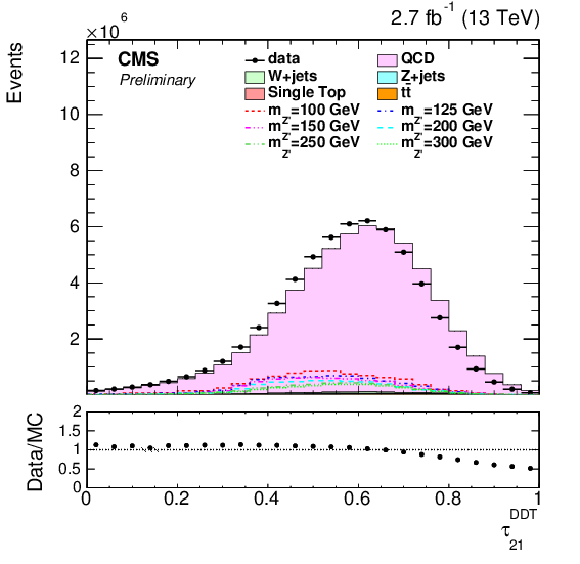
png pdf |
Figure 3-b:
Data-to-simulation comparison of the leading pT jet soft drop mass (a) and τDDT21 (b) after kinematic selections on the leading pT jet which is dominated by QCD multijet processes (pink) with subdominant contributions from inclusive SM W, Z, and tˉt processes. Residual differences in data and simulation demonstrate the need for a data-driven background estimation method. |
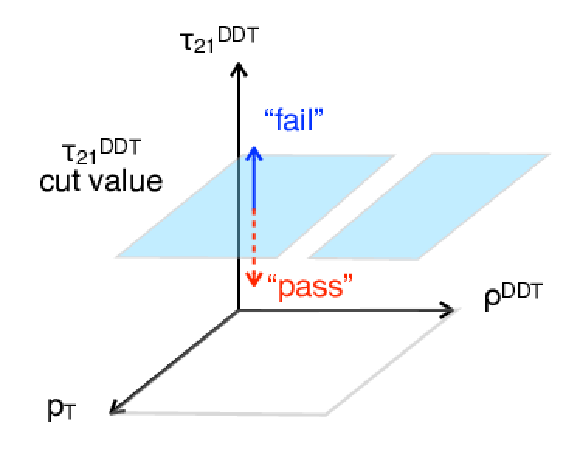
png pdf |
Figure 4-a:
a: Diagram illustrating the background estimation technique which estimates the signal region (``pass") QCD background distribution from the sideband region (``fail") in the {ρDDT,pT} phase space. The empty strip in the pass-to-fail plane is the signal region in ρDDT (or jet mass) for a given Z' mass. b: The transfer factor TF(ρDDT,pT) space, now interpolated over the signal region, for a Z' with a mass of 110 GeV as measured in data which translates ``fail" region events into the signal region. |

png pdf |
Figure 4-b:
a: Diagram illustrating the background estimation technique which estimates the signal region (``pass") QCD background distribution from the sideband region (``fail") in the {ρDDT,pT} phase space. The empty strip in the pass-to-fail plane is the signal region in ρDDT (or jet mass) for a given Z' mass. b: The transfer factor TF(ρDDT,pT) space, now interpolated over the signal region, for a Z' with a mass of 110 GeV as measured in data which translates ``fail" region events into the signal region. |
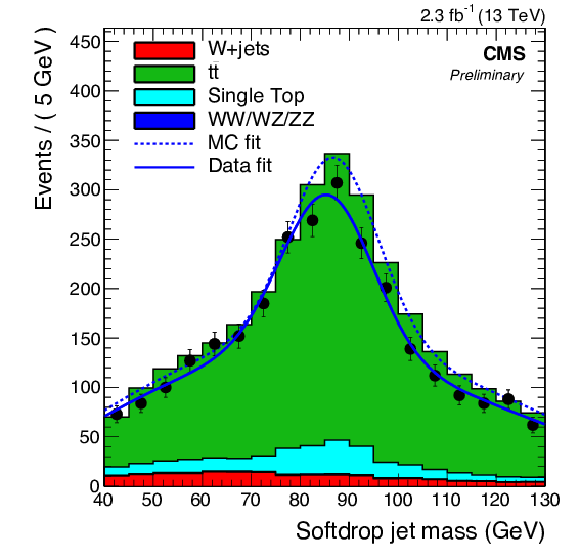
png pdf |
Figure 5-a:
Distributions of merged W jets in the fail (a) and pass (b) regions of the semi-leptonic tˉt control region shown both for data and MC. A simultaneous fit of the two samples is performed to extract the W-tagging efficiency in both simulation (dotted blue lines) and data (solid blue lines). |

png pdf |
Figure 5-b:
Distributions of merged W jets in the fail (a) and pass (b) regions of the semi-leptonic tˉt control region shown both for data and MC. A simultaneous fit of the two samples is performed to extract the W-tagging efficiency in both simulation (dotted blue lines) and data (solid blue lines). |

png pdf |
Figure 6-a:
Final inputs to the statistical interpretation for a Z' mass of 135 GeV (a) and 200 GeV (b). The QCD background prediction, including uncertainties, is shown in the blue boxes while the sum of the SM processes is shown in the blue line. Contributions from the W, Z, and Z' are given as well. In the bottom panel, the ratio of the data to the background prediction, including uncertainties, is shown. |

png pdf |
Figure 6-b:
Final inputs to the statistical interpretation for a Z' mass of 135 GeV (a) and 200 GeV (b). The QCD background prediction, including uncertainties, is shown in the blue boxes while the sum of the SM processes is shown in the blue line. Contributions from the W, Z, and Z' are given as well. In the bottom panel, the ratio of the data to the background prediction, including uncertainties, is shown. |
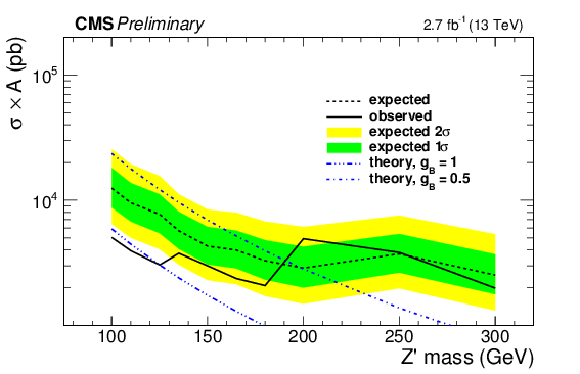
png pdf |
Figure 7-a:
95% confidence level upper limit on the Z' production cross section compared to the theoretical cross section for a Z' with gB=0.5,1 (a) and the translation of that upper limit to a limit on gB (b). Limits from other relevant searches are also shown. Recent ATLAS results from Run 2 in [36,26] are scaled to the coupling gB. |

png pdf |
Figure 7-b:
95% confidence level upper limit on the Z' production cross section compared to the theoretical cross section for a Z' with gB=0.5,1 (a) and the translation of that upper limit to a limit on gB (b). Limits from other relevant searches are also shown. Recent ATLAS results from Run 2 in [36,26] are scaled to the coupling gB. |
| Tables | |

png pdf |
Table 1:
Summary of the systematic uncertainties for signal and background. Symbol ‡ denotes this is only applied to Z' signal. Symbol † denotes a shape uncertainty on the peaking SM W/Z and Z' signal shape. Symbol △ denotes EWK uncertainties are also included for the SM W/Z processes. |
| Summary |
| We present the first limits on a search for a light Z' boson decaying to a quark-antiquark pair in the mass range from 100-300 GeV with the CMS detector. We do not observe any excess above the SM prediction and set limits on the Z' coupling to quarks, gB, as a function of the Z' mass. Our limits are the most stringent in the mass range less than 300 GeV. For masses below 140 GeV, they are the only limits set. |
| Additional Figures | |
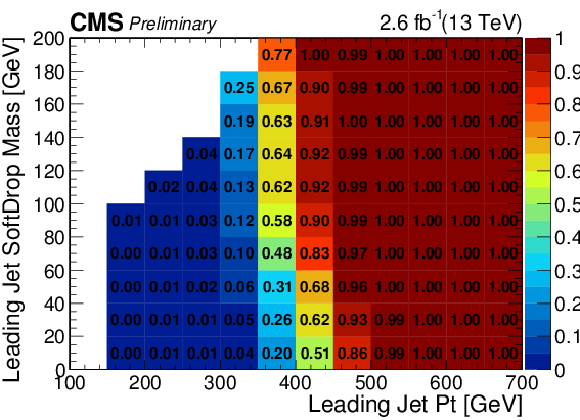
png pdf |
Additional Figure 1:
Trigger efficiency as a function of the leading jet pT and soft drop mass measured in using the data. |
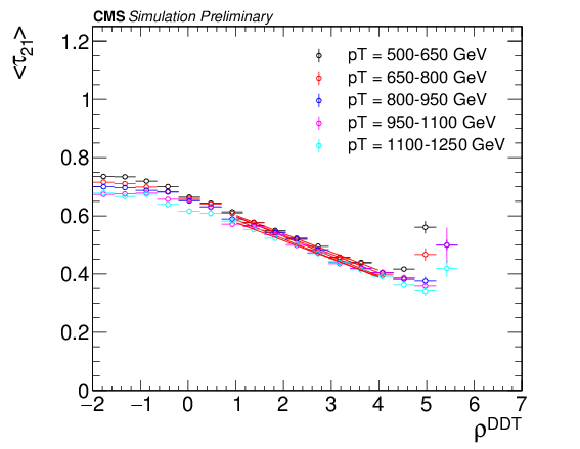
png pdf |
Additional Figure 2:
Profiled distribution of τ21 versus ρDDT for multijet QCD MC, for different leading jet pT values, which demonstrates the correlation of the variables using the DDT transformation. The region where ρDDT<0, corresponds to very small jet mass values we do not probe in this analysis, while the non-linear region where ρDDT> 4.7 corresponds to high mass jet values where ρDDT acquires non-physical values for a given pT. Error bars denote the uncertainty on the mean for the profiled distributions. |

png pdf |
Additional Figure 3:
Signal mass distributions for various simulated Z' masses probed in this analysis after applying the final analysis selection. |

png pdf |
Additional Figure 4:
The 95% confidence level upper limit on the coupling gB as a function of the Z' mass. Limits from other relevant searches are also shown. Recent ATLAS results from Run 2 in [ATLAS-CONF-2016-029,ATLAS-CONF-2016-030] are scaled to the coupling gB. |
| References | ||||
| 1 | L. A. Anchordoqui et al. | Dijet signals for low mass strings at the LHC | PRL 101 (2008) 241803 | 0808.0497 |
| 2 | S. Cullen, M. Perelstein, and M. E. Peskin | TeV strings and collider probes of large extra dimensions | PRD 62 (2000) 055012 | hep-ph/0001166 |
| 3 | J. L. Hewett and T. G. Rizzo | Low-Energy Phenomenology of Superstring Inspired E(6) Models | PR 183 (1989) 193 | |
| 4 | U. Baur, I. Hinchliffe, and D. Zeppenfeld | Excited Quark Production at Hadron Colliders | Int. J. Mod. Phys. A 2 (1987) 1285 | |
| 5 | U. Baur, M. Spira, and P. Zerwas | Excited quark and lepton production at hadron colliders | PRD 42 (1990) 815--824 | |
| 6 | P. H. Frampton and S. L. Glashow | Chiral Color: An Alternative to the Standard Model | PLB 190 (1987) 157 | |
| 7 | R. S. Chivukula, A. Farzinnia, E. H. Simmons, and R. Foadi | Production of Massive Color-Octet Vector Bosons at Next-to-Leading Order | PRD 85 (2012) 054005 | 1111.7261 |
| 8 | E. H. Simmons | Coloron phenomenology | PRD 55 (1997) 1678--1683 | hep-ph/9608269 |
| 9 | T. Han, I. Lewis, and Z. Liu | Colored Resonant Signals at the LHC: Largest Rate and Simplest Topology | JHEP 1012 (2010) 085 | 1010.4309 |
| 10 | E. Eichten, I. Hinchliffe, K. D. Lane, and C. Quigg | Super Collider Physics | Rev. Mod. Phys. 56 (1984) 579--707 | |
| 11 | L. Randall and R. Sundrum | An Alternative to compactification | PRL 83 (1999) 4690--4693 | hep-th/9906064 |
| 12 | UA1 Collaboration | Two Jet Mass Distributions at the CERN Proton - Anti-Proton Collider | PLB 209 (1988) 127--134 | |
| 13 | UA2 Collaboration | A Measurement of two jet decays of the W and Z bosons at the CERN ˉpp collider | Z. Phys. C 49 (1991) 17--28 | |
| 14 | UA2 Collaboration | A Search for new intermediate vector mesons and excited quarks decaying to two jets at the CERN ˉpp collider | Nucl. Phys. B 400 (1993) 3--24 | |
| 15 | CDF Collaboration | The Two jet invariant mass distribution at √s=1.8 TeV | PRD 41 (1990) 1722--1725 | |
| 16 | CDF Collaboration | Search for quark compositeness, axigluons and heavy particles using the dijet invariant mass spectrum observed in pˉp collisions | PRL 71 (1993) 2542--2546 | |
| 17 | CDF Collaboration | Search for new particles decaying to dijets in pˉp collisions at √s=1.8 TeV | PRL 74 (1995) 3538--3543 | hep-ex/9501001 |
| 18 | CDF Collaboration | Search for new particles decaying to dijets at CDF | PRD 55 (1997) 5263--5268 | hep-ex/9702004 |
| 19 | CDF Collaboration | Search for new particles decaying into dijets in proton-antiproton collisions at s**(1/2) = 1.96-TeV | PRD 79 (2009) 112002 | 0812.4036 |
| 20 | D0 Collaboration | Search for new particles in the two jet decay channel with the D0 detector | PRD 69 (2004) 111101 | hep-ex/0308033 |
| 21 | ATLAS Collaboration | Search for New Particles in Two-Jet Final States in 7 TeV Proton-Proton Collisions with the ATLAS Detector at the LHC | PRL 105 (2010) 161801 | 1008.2461 |
| 22 | ATLAS Collaboration | Search for New Physics in Dijet Mass and Angular Distributions in pp Collisions at √s=7 TeV Measured with the ATLAS Detector | New J. Phys. 13 (2011) 053044 | 1103.3864 |
| 23 | ATLAS Collaboration | Search for New Physics in the Dijet Mass Distribution using 1 fb−1 of pp Collision Data at √s=7 TeV collected by the ATLAS Detector | PLB 708 (2012) 37--54 | 1108.6311 |
| 24 | ATLAS Collaboration | ATLAS search for new phenomena in dijet mass and angular distributions using pp collisions at √s=7 TeV | JHEP 01 (2013) 029 | 1210.1718 |
| 25 | ATLAS Collaboration | Search for new phenomena in the dijet mass distribution using p−p collision data at √s=8 TeV with the ATLAS detector | PRD 91 (2015), no. 5, 052007 | 1407.1376 |
| 26 | ATLAS Collaboration Collaboration | Search for light dijet resonances with the ATLAS detector using a Trigger-Level Analysis in LHC pp collisions at √s=13~TeV | Technical Report ATLAS-CONF-2016-030, CERN, Geneva, Jun | |
| 27 | ATLAS Collaboration | Search for new phenomena in dijet mass and angular distributions from pp collisions at √s= 13 TeV with the ATLAS detector | PLB754 (2016) 302--322 | 1512.01530 |
| 28 | CMS Collaboration | Search for Dijet Resonances in 7 TeV pp Collisions at CMS | PRL 105 (2010) 211801 | CMS-EXO-10-010 1010.0203 |
| 29 | CMS Collaboration | Search for Resonances in the Dijet Mass Spectrum from 7 TeV pp Collisions at CMS | PLB 704 (2011) 123--142 | CMS-EXO-11-015 1107.4771 |
| 30 | CMS Collaboration | Search for narrow resonances and quantum black holes in inclusive and b-tagged dijet mass spectra from pp collisions at √s=7 TeV | JHEP 01 (2013) 013 | CMS-EXO-11-094 1210.2387 |
| 31 | CMS Collaboration | Search for narrow resonances using the dijet mass spectrum in pp collisions at √s=8 TeV | PRD 87 (2013), no. 11, 114015 | CMS-EXO-12-016 1302.4794 |
| 32 | CMS Collaboration | Search for resonances and quantum black holes using dijet mass spectra in proton-proton collisions at √s= 8 TeV | PRD 91 (2015), no. 5, 052009 | CMS-EXO-12-059 1501.04198 |
| 33 | CMS Collaboration | Search for narrow resonances decaying to dijets in proton-proton collisions at √(s)= 13 TeV | PRL 116 (2016), no. 7, 071801 | CMS-EXO-15-001 1512.01224 |
| 34 | CMS Collaboration | Search for narrow resonances in dijet final states at sqrt(s)=8 TeV with the novel CMS technique of data scouting | CMS-EXO-14-005 1604.08907 |
|
| 35 | R. M. Harris and K. Kousouris | Searches for Dijet Resonances at Hadron Colliders | Int. J. Mod. Phys. A 26 (2011) 5005--5055 | 1110.5302 |
| 36 | ATLAS Collaboration Collaboration | Search for new light resonances decaying to jet pairs and produced in association with a photon in proton-proton collisions at √s=13~TeV with the ATLAS detector | Technical Report ATLAS-CONF-2016-029, CERN, Geneva, Jun | |
| 37 | B. A. Dobrescu and F. Yu | Coupling-mass mapping of dijet peak searches | PRD 88 (2013), no. 3, 035021 | 1306.2629 |
| 38 | CMS Collaboration | The CMS experiment at the CERN LHC | JINST 3 (2008) S08004 | CMS-00-001 |
| 39 | D. Krohn, J. Thaler, and L.-T. Wang | Jet Trimming | JHEP 02 (2010) 084 | 0912.1342 |
| 40 | M. Cacciari, G. P. Salam, and G. Soyez | The anti-kt jet clustering algorithm | JHEP 04 (2008) 063 | 0802.1189 |
| 41 | J. Alwall et al. | The automated computation of tree-level and next-to-leading order differential cross sections, and their matching to parton shower simulations | JHEP 07 (2014) 079 | 1405.0301 |
| 42 | T. Sj\"ostrand, S. Mrenna, and P. Skands | PYTHIA 6.4 physics and manual | JHEP 05 (2006) 026 | hep-ph/0603175 |
| 43 | T. Sjostrand, S. Mrenna, and P. Z. Skands | A Brief Introduction to PYTHIA 8.1 | CPC 178 (2008) 852--867 | 0710.3820 |
| 44 | S. Kallweit et al. | NLO electroweak automation and precise predictions for W+multijet production at the LHC | JHEP 04 (2015) 012 | 1412.5157 |
| 45 | S. Kallweit et al. | NLO QCD+EW predictions for V + jets including off-shell vector-boson decays and multijet merging | JHEP 04 (2016) 021 | 1511.08692 |
| 46 | S. Kallweit et al. | NLO QCD+EW automation and precise predictions for V+multijet production | in Proceedings, 50th Rencontres de Moriond, QCD and high energy interactions, pp. 121--124 2015 | 1505.05704 |
| 47 | D. Bertolini, P. Harris, M. Low, and N. Tran | Pileup Per Particle Identification | JHEP 10 (2014) 059 | 1407.6013 |
| 48 | M. Dasgupta, A. Fregoso, S. Marzani, and G. P. Salam | Towards an understanding of jet substructure | JHEP 09 (2013) 029 | 1307.0007 |
| 49 | A. J. Larkoski, S. Marzani, G. Soyez, and J. Thaler | Soft Drop | JHEP 05 (2014) 146 | 1402.2657 |
| 50 | CMS Collaboration | Identification techniques for highly boosted W bosons that decay into hadrons | JHEP 12 (2014) 017 | CMS-JME-13-006 1410.4227 |
| 51 | CMS Collaboration | Search for massive resonances decaying into pairs of boosted bosons in semi-leptonic final states at √s= 8 TeV | JHEP 08 (2014) 174 | CMS-EXO-13-009 1405.3447 |
| 52 | CMS Collaboration | Search for massive resonances in dijet systems containing jets tagged as W or Z boson decays in pp collisions at √s = 8 TeV | JHEP 08 (2014) 173 | CMS-EXO-12-024 1405.1994 |
| 53 | J. Dolen et al. | Thinking outside the ROCs: Designing Decorrelated Taggers (DDT) for jet substructure | 1603.00027 | |
| 54 | G. P. Salam | Towards Jetography | EPJC67 (2010) 637--686 | 0906.1833 |
| 55 | A. L. Read | Presentation of search results: the CLs technique | JPG 28 (2002) 2693 | |
| 56 | T. Junk | Confidence level computation for combining searches with small statistics | NIMA 434 (1999) 435 | hep-ex/9902006 |
| 57 | D. Abercrombie et al. | Dark Matter Benchmark Models for Early LHC Run-2 Searches: Report of the ATLAS/CMS Dark Matter Forum | 1507.00966 | |

|
Compact Muon Solenoid LHC, CERN |

|

|

|

|

|

|